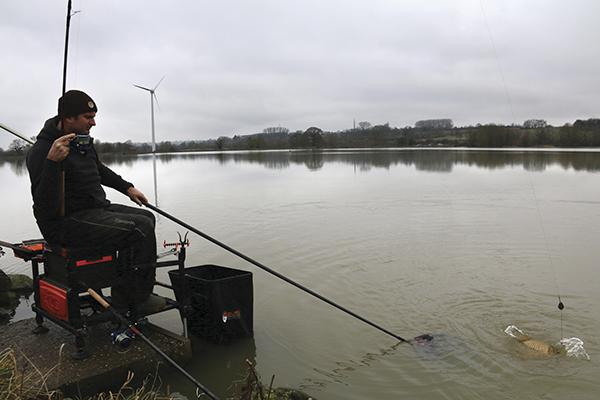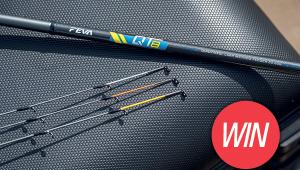Master The Creep

Carping through the winter months is very different to fishing in summer, not just in the volumes of bait we feed but the way we feed it. While the water is at its coldest, it simply isn’t possible to build a peg; in fact, on venues where the carp are particularly big, I would go as far to say that each subsequent cast in fact spooks fish and damages the peg! The solution that more anglers have started to cotton on to now is to start short, then slowly work your way out into the lake, picking off fish as you slowly spook them into the centre of the lake.
This doesn’t mean however, that ‘the creep’ will work on every venue, as the circumstances need to be dead right. Barston for example at first glance seems like it should be the perfect creep venue; however, carp are not the only target as bream and F1s can also put in an appearance. This means more regular casting and as a result, smaller feeders. You still can’t build a peg at Barston, but creeping isn’t quite right as the fish cannot necessarily escape by sitting in the middle of the lake as it is small enough for everyone to cast there. Due to this, I would call Barston more of a feeder dobbing venue.
Where the creep does work however, is where the carp are particularly large and three to eight bites could win the match, there aren’t many other smaller species to be caught and create competition and the venue is expansive enough for no one to be able to cast to the middle. As you have probably already guessed, I’m talking about Boddington!
Where To Start
Starting distance does very much depend on the venue and can only really come from experience. The first cast of the day is the most important as that defines how the rest of the day goes. Cast too short and you won’t catch and will give the anglers around you a chance of a head start. Cast too long and you could cast past the fish and run out of creeping distance later in the day as you reach your casting limit too early.
Once you’ve cast a distance, there is no going back. Winding a feeder back past the fish simply spooks them. I can count on one hand the amount of times I have reduced my casting distance throughout the day at Boddington in winter and actually caught!
Today, I’m sat on the south bank and like most of the reservoir, my starting distance is 75 metres. If I was sat on the dam wall, or west bank as it is also known, the fish do tend to sit a bit closer and I’ve made the mistake of starting too far out in the past and ended up having a blank first hour while anglers around me have caught up to four fish each! As I’ve already said, dropping shorter after doing this rarely works and I will have already spooked the fish that were in front of me off to the side and pushed them in front of my neighbours! By learning the hard way, my starting distance on the dam is now 60 metres.
The final thing that affects starting distance is your own maximum casting distance. In fair conditions, I tend to think of my maximum cast as being 100 metres. Yes, I can quite often get further than this, but wind has a huge effect and the slightest breeze can knock metres off your cast. The last thing I want to do is try for a distance that I cannot hit and crash the feeder into the water. Unless you’ve hit the clip and the feeder has landed well, you might as well reel in as it’s doubtful your bait will have stayed on the feeder after impact.
Starting at 75 metres gives me 25 metres of safe creeping distance, with the chance of really pushing it and going further if needed. It’s well worth knowing your own maximum casting distance and the only way to truly know that is by using measuring sticks.
Where this now all comes apart of course is when it’s windy. In a howling gale, 80 metres becomes the new 100 metres, which in turn reduces the starting distance too!
Decision Time
I’ve now made my initial cast, then started my stopwatch.
Although I’m not going to go into too much detail about kit in this feature, it is important for you to know that I am using a large Hybrid feeder. The feeder needs to be left in the water for anything from 20 minutes to an hour to get a bite. Boddington is a huge water and I need to make sure there is enough attraction from the bait on my feeder to draw a fish in and to ensure that there is still bait around the feeder after all that time. The only thing I vary is the weight, as I use anything from 45g to 60g depending on distance.
I also try to make my bait as attractive as possible. My pellets are a 75:25 mix of Ringers Method Micros and Dynamite F1 Sweet 2mm, with added crushed boilies. I’ve even soaked the crushed boilies in F1 Sweet Pellet Soak to add yet more flavour and to ensure it doesn’t float. Goo is another attractor that I like to use, but I like it as an impact bait that I can smear on to my feeder at some point in the match to give the fish something different and to pick off an extra fish. What I do now very much depends on what happens next.
Scenario One – I catch a carp.
This is of course the best thing that can happen! There could be more carp close by, so I recast to the same distance. If I then don’t catch within 30 minutes, I will add two metres to the clip, reel in then recast. If after yet another 30 minutes I don’t get another, I will add four metres and cast again. If at any point I catch a carp, I will recast to the same spot and repeat the process.
Scenario Two – After 30 minutes I’ve not caught, but others in my section have.
There are a few carp about, but I’ve obviously not reached them yet. Before I reel in, I add a significant distance of five metres to my clip.
Scenario Three – After 30 minutes I’ve not caught and hardly anything has been caught in my section.
This signals to me that the day is going to be rock hard! It is also possible that very long casts could be best so I will then wait another 15 minutes before I reel in, just to see if I can bore one on to the hook. If I catch, then I will recast just two metres further and again, aim to wait up to 45 minutes for a bite.
If after 45 minutes of the start of the match and I’m still on my first cast, I will add five metres to the clip in a bid to reach some fish before reeling in and trying again. If an odd fish now gets caught, I will have the confidence to continue, but if after an hour of the match and still hardly anyone has caught, I now know that just one fish will be needed to do well. I will abandon the cast, re-clip using the measuring sticks at 100 metres and get straight out to near my maximum distance.
As long as the feeder lands correctly, I will then leave it in the water for up to an hour at a time. After that I will try to go even further, but to do this means putting your all into the cast and is easier said than done!
Scenario Four – It’s windy and towing hard.
This is where it all changes. Not only do the waves on the water mask the entry of the feeder to the water, but the tow will slowly drag all the bait off your feeder. In this situation I will still follow my basic rule of recasting to the same spot if I catch, cast two metres further if not and four metres further if I haven’t caught in two casts, but the maximum time I will leave the feeder in the water will be 20 minutes.
Confidence
The final part of the jigsaw is confidence. This type of fishing means a lot of time spent in the water and feeding very little. Casting straight out into the abyss with just a loaded feeder takes some bottle, so having the confidence to do so is massively important. There is no time to waste messing around with different hook bait options or wondering if your setup is correct. If you have not already done so, get out on the bank and find a hook bait you are confident in, a pellet mix that is right and a setup that you will land every fish on. Once you have earned your confidence, you are then ready to try it in a match. Good luck!
- Log in or register to post comments












